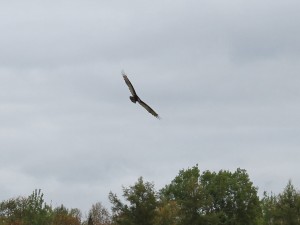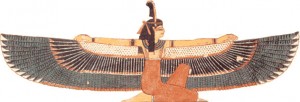Turkey Vulture in Rowena

It was a glorious fall day and I was driving along in a peaceful kind of trance when I saw, up ahead in the distance, the familiar sight of a large black bird feasting on road kill.
I assumed it was a raven, and it did not fly away as I approached. The closer I got, however, the bigger the bird got. In fact, just as I was thinking that it was the biggest darned raven I had ever seen I drove past it. It raised its bald red head to look up at me and I was startled to realize that it was a turkey vulture.
This was the first time I had ever seen one of these magnificent birds in New Brunswick. I grew up in Florida where, out in the country, you’d typically see many turkey vultures on any given day, high up in the sky soaring on the thermal updrafts and air currents. I assumed it was too cold this far north for these birds to live.
As soon as I could turn around, I headed back and parked down the road a discreet distance from the vulture, hoping to be able to sneak up close enough to get some good photographs.
The vulture was having none of it…as soon as I opened my car door it took off with a mighty flap of its wings and proceeded to soar overhead for as long as I was there. I thought if I gave it some time and stood quietly it would return to its meal (the remains of a porcupine) but the vulture had a lot more patience than me.
It swooped and sailed and put on a beautiful aerial display over my head but clearly was not going to land while I was hanging about in the neighbourhood!
After I amused myself by trying….and not succeeding… to wait out the vulture to get close-up photos, I walked up the road a bit to see if I would be fortunate enough to find a dropped feather for my collection. No such luck this day!
Since this was such an unusual sighting I wondered if it was some sort of message from nature. When I got home I looked up vulture in a book on animal symbolism.
I was bemused to read what turkey vulture means when it appears as a totem to you. It said that if vulture comes into your life you may have digestive issues and it could also indicate a need to change your diet. Just what I was in the hospital for a few months back. The Universe does have an ironic sense of humour!
Turkey vultures have gotten a bad rap because they are seen as scavengers who represent death. And that bald head is not exactly beauteous to behold!
The ancient Greeks considered the vulture a descendant of the griffin, a mythical creature who was a guardian to the mysteries of life and death.
The Pueblo Indians saw it as a symbol of purification whose medicine would restore harmony to what had been broken and its feathers are used in grounding and shape-shifting ceremonies.

By devouring corpses, it serves the very necessary function of disposing of what could carry infection and bacteria thus preventing the spread of disease.
Turkey vultures are ungainly on the ground, but when they rise into the air they are incredibly graceful. Their sensitivity to thermal currents enables them to soar for hours without ever flapping their wings.
There’s a very neat fable explaining how vulture came to have that unlovely bald head.
In the earliest of times, the sun lived very close to the earth….so close in fact that life upon the earth was becoming unbearable. The animal world got together and decided to do something about it. They wanted to move the sun further away. The fox was the first to volunteer, and he grabbed the sun in his mouth and began to run to the heavens. After a short while, the sun became too hot, burning the fox’s mouth, and he stopped. To this day, the inside of the fox’s mouth is black.
Then the opossum volunteered. He wrapped his tail around the sun and began running toward the heavens. Before long though the sun became too hot, burning his tail, and he had to stop. To this day the opossum has no hair upon its tail.
It was then that vulture stepped forward. Vulture was the most beautiful and powerful of birds. Upon its head was a glorious mantle of rich feathers that all the other birds envied. Knowing that the earth would burn up unless someone moved the sun, the vulture placed his head against it and began to fly to the heavens. Though it could feel its crown feathers burning, vulture continued until the sun was at a safe distance in the sky away from earth. Vulture saved earth but lost its magnificent head of feathers for all eternity.
